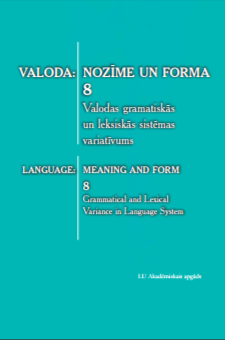Place names and places in Latvia
Place names and places in Latvia
Author(s): Ojārs Bušs, Laimute BalodeSubject(s): Language studies, Lexis, Baltic Languages
Published by: Latvijas Universitātes Akadēmiskais apgāds
Keywords: onomastics; place; toponym; microtoponym; derivation of place names; location;
Summary/Abstract: The first part of this article is devoted to the Latvian lexeme vieta ‘place’, which is a rather rare place name – approximately 200 such toponyms (mostly microtoponyms) occur in the card index of Latvian place names of the Latvian Language Institute (University of Latvia). This is a peculiar generic lexeme, used as the second of what is referred to as an independent component of compound names or collocations, to some extent semantically empty so that without prior knowledge, it is not obvious what type of geographic object is being named. However, it cannot be claimed that the toponymic component vieta has no meaning, as its most common meaning is ‘the place, where some object or phenomenon has existed earlier’ (Šķūņa vieta, Cepļa vieta), reflecting memories of the past. A rarer alternative is the type of names that are associated with an object that exists at present. Even fewer toponyms with the second component vieta are related to some person (expressing possessive meaning), to some processes, associations, etc. Furthermore, it is surprising that a massive concentration of those vieta-names are found in Eastern Latvia or Latgale. The second part of the article introduces the study of Latvian place names that indicate a location regarding another place name. These are compound names and collocations that have as their first component Augš- ‘upper-’, Apakš- ‘below’, Virs- ‘over, above’, Starp- ‘between’, Zem- ‘under-’, etc. Place names with Kalna-/Kaln- ‘hill-, upper- and Lejas-/Lej- ‘valley-, lower-’ are very often used as toponymic antonyms (Lejasteteri – Kalnteteri). The most prevalent prefixes, which help to navigate regarding other topo-objects, are Aiz-, Pa-, Pār-; only a few examples have been recorded with the formants Starp-, Iekš-, Priekš-. For this latter type of toponym, another place name or nomenclature word usual serve as an etymon.
Journal: Valoda: nozīme un forma
- Issue Year: 2017
- Issue No: 8
- Page Range: 140-151
- Page Count: 12
- Language: English

